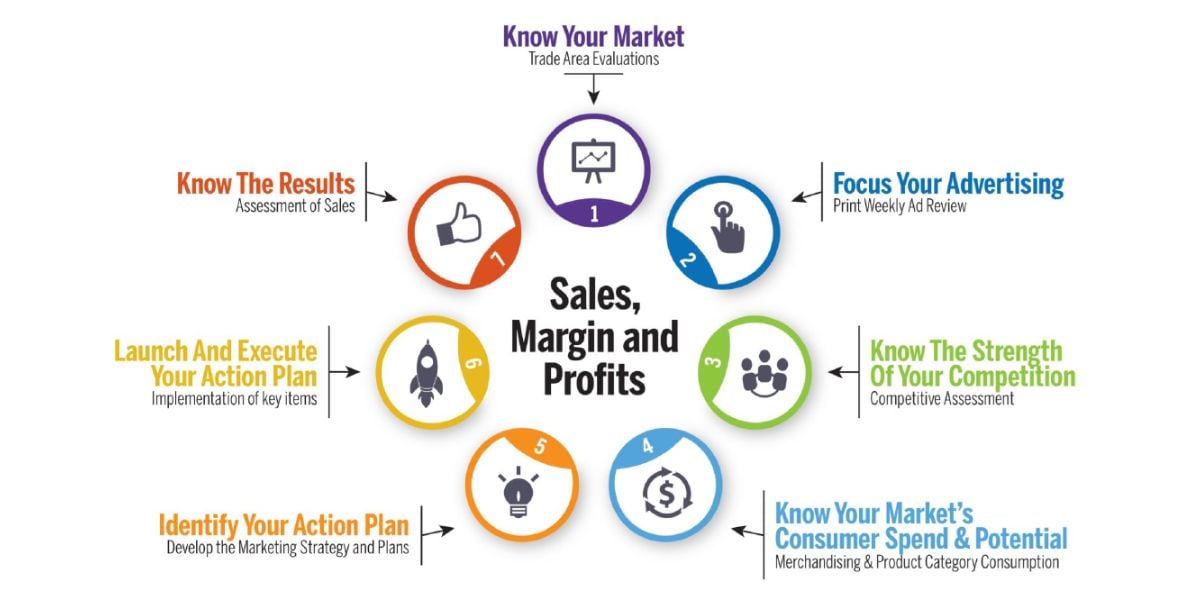Help Isom IGA recover from devasting floods

5 min read
How Well Do You Know Your Marketplace? 360° Analysis Serves Up The Data
Written by Ashley M Page
May 25, 2023
With new competitors, technologies, and shifting consumer demographics and trends, the grocery marketplace is changing rapidly. But with the countless day-to-day operational challenges independent grocery retailers face, even the best grocery operators can get stuck in a business-as-usual mentality.
“It’s not that independents don’t know that the business is changing rapidly. It’s simply that many don’t know where to begin to address it,” says Leigh Englebrecht, president of ADvay Media Group, a marketplace and media analysis company that is a division of the Independent Grocers Alliance. “If the perception of your marketplace is based only on the customers coming through your door, it’s easy to lull yourself into believing that changing customer demographics is something to worry about down the road rather than today. The reality is it’s becoming an exponentially bigger problem every day it’s ignored.”
Data from the last U.S. Census offers insight into just how quickly communities are evolving. America has become much more racially and ethnically diverse over the past decade, particularly in the last several years. A Brookings Institute analysis of the data found that 24% of rural Americans are now people of color:the median rural county saw its population of color increase by 3.5 percentage points between 2010 and 2020, with the rural Hispanic population alone increasing by 19.7%.
“It’s not uncommon for a retailer to have a completely inaccurate perception of their marketplace demographics,” Englebrecht says, citing an example of a retailer who thought the customer base in his area was largely white, but after a demographic analysis found it was 40% Hispanic.
A false perception of your marketplace means you’re missing out on new customers and potential sales, but Englebrecht stresses there will likely be another less obvious consequence: wasted advertising dollars.
“You advertise to a specific audience. So if your ad spending is going to completely irrelevant audiences, you could be losing tens of thousands of dollars.”
As a grocer, how can you ensure what you think about your community and marketplace matches up with reality? It all starts with having the right data. That’s where ADvay’s 360° Analysis program comes into play.
Combining shopper demographics and behaviors with your own store-specific sales data, the 360° Analysis program gives you the insight you need to make educated business decisions for everything from long-term planning goals to marketing, merchandising, and of course, advertising.
According to Englebrecht, implementing accurate data and analytics into your ad spend can save your margins and improve sales dramatically.
“On average, we find retailers save more than $10,000 annually on advertising when they work with us to create a media plan that better reflects their trade area’s customers' media consumption.”
How It Works
For 360° Analysis to provide all the insight you need, data is gathered from over 7,000 U.S. consumer data points. This includes over 82 million mobile phones in the U.S. and their location data. ADvay receives legal access to these sources.
The reports deliver detailed population and employment information for your local area within 5, 10, 15-minute drive times, including population trends, retail marketplace profiles, etc.
![]() AdVay's cell tracking capabilities show where a retailer's customers live and what competitors they shop with.
AdVay's cell tracking capabilities show where a retailer's customers live and what competitors they shop with.
ADvay pairs those findings with a deep dive into shopper and employee satisfaction via a survey component through the Retail Learning Institute, and finally creates and helps you execute a detailed plan to help you grow sales — complete with follow up analysis to show you how it’s working.
7 Steps to Success

- Trade Area Evaluation: Analyze how your market varies between a 5-minute drive time and a 10 to 15-minute drive time from your store. This step reveals current and potential customers.
- Weekly Print Ad Review: See how effective your print advertising is and identify ways to save. 85% of all ADvay Print reviews find savings and 10% of all reviews find media coverage holes.
- Competitive Analysis: Identify how strong are your local Walmarts, Dollar Stores and other grocery competition within a 5, 10 and 15-minute drive time.
- Key Categories to Grow Market Share: Identify the category benchmarks of consumer spend and food at home within a 10-minute drive time and see how your market index compares to a national average.
- Develop a Marketing Strategy and Plan: ADvay will identify your strengths and weaknesses and partner with you to develop a strategic and executable merchandising and marketing plan to be implemented within the next quarter.
- Implementation of Key Findings: ADvay will assist with key elements of your personalized Action Plan while you execute at store level.
- Assessment of Sales: Once your action plan has been implemented, retail sales are tracked at category and sub-category levels. Results are reported monthly with a quarterly review.
Proven Results
According to Englebrecht, the goal of the 360° Analysis process is simple: Pair science (the data side) with creativity (the marketing side) to give independents a blueprint to save money, grow market share and sales, and increase customer and team member loyalty.
And it works. “We’ve done this process hundreds of times in stores in the U.S., and recently have expanded this same process to overseas,” he says, referencing WalterMart, a Filipino chain of community shopping malls anchored by grocery stores. “It works in every scenario; in the Philippines, we are already eight points ahead of plan.”
Spires IGA Market in Lake Butler, Florida used ADvay's 360° Analysis and experienced the following improvements (Year over Year):
- Learned how to prioritize advertising expenditures. By matching customer homes to where the print ad was being distributed and discontinuing inefficient print ad distribution, Spires IGA Market redirected advertising spend into the most cost-effective channels. While they did not entirely eliminate print ads, these efforts decreased costs by nearly $1,000 per week.
- Implemented new digital marketing programs, available at a lower cost for directly advertising to the shopper. Spires IGA Market updated their communication strategy to leverage social media to reach existing shoppers. They adjusted their messaging to promote the store's unique value through "locally famous" meals to go and their long history as the oldest independently owned supermarket in Florida.
Through targeted digital advertising, they ensure their desired message finds the shopper, as opposed to the shopper needing to find the retailer. - Average basket size increased by $1.03.
- Weekly customer count up by 63 customers.
- Store sales up over 15%.
- Cross shopping analysis revealed fewer loyal Spires IGA Market shoppers were visiting competitors' stores.
How Can I Get Started?
With IGA’s 360° Analysis, you’ll take the right steps with proper guidance into gaining meaningful shopper feedback to improve your business and stay competitive. You’ll know exactly who you are marketing to, giving you peace of mind in your advertising budget.
Click here to learn more and download our 360° Analysis.
No Comments Yet
Let us know what you think